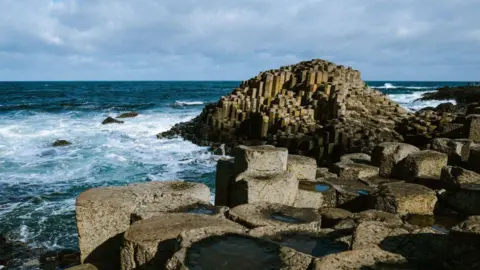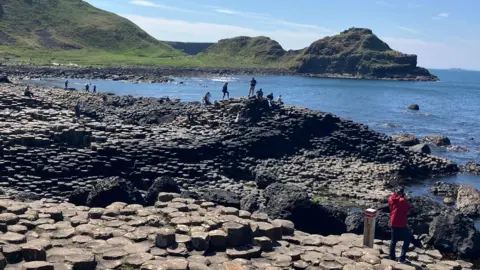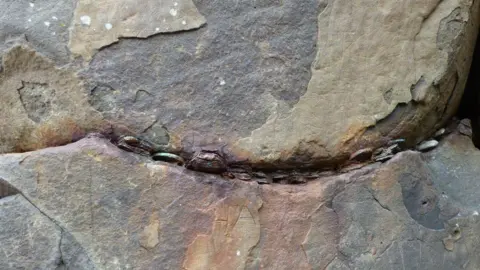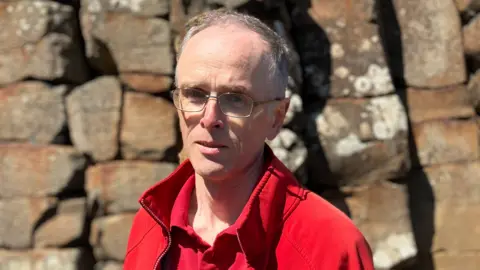Giant's Causeway visitors urged not to jam coins into iconic rocks
 Getty Images
Getty ImagesThe Giant's Causeway has faced many threats to its survival, from mythical fights between giants to coastal erosion and rising sea levels.
Now there's a new problem.
At first, you don't notice them but as soon as you see one, you start to see them everywhere - hundreds of them, in every fissure and crevice.
They are coins, inserted into the tiny gaps between one of Northern Ireland's most famous and photographed natural resources, the basalt columns of the Giant's Causeway.

Like the padlocks left on the Pont des Arts bridge in Paris, people often leave the coins behind for love or luck.
But, like that tradition, the coins are causing problems, and now visitors are being asked to keep their spare change in their pockets.
In Paris, it has been made illegal to attach a padlock after part of the bridge collapsed in 2014.
At the Giant's Causeway, the practice started years ago – but the caretakers for the site, the National Trust, believe it has increased significantly in scale in the last decade or so.
Hundreds of thousands of tourists and locals visit each year and only a fraction leave behind this unwanted memento.
But the coins are having a direct impact on the rocks themselves. The worst affected are the basalt columns that make up The Loom – 10 ft high leaning towers of rock.
 National Trust
National TrustThey are a slightly lighter colour than the iconic hexagonal black basalt at the point of the causeway.
It is easy to see at first glance the discolouration caused by the coins - a reddish-brown wash over the surface.
Dr Cliff Henry, nature engagement officer with the National Trust, said the rocks are affected on a number of levels.
"People see others put coins in, so they copycat, they take a coin out of their pocket and they might take a stone off the ground to hammer the coin in, but they might miss and chip the stone itself so that's doing damage."

He added: "Once the coin is in there it starts to rust and due to the atmosphere here it rusts at an accelerated level.
"The coin then expands and that's putting pressure on the joint near the edge so we have seen on a number of places here that the corners have popped off.
"And the rusting metal in there is starting to leach. The iron and nickel and copper is leaching out over the rocks and it looks unsightly."
He said they're appealing to people to stop inserting the coins before more damage is done to these 60-million-year-old rocks.
"On a geological timescale, this is very rapid erosion."
A report from the Geological Survey of Northern Ireland shed some light on the problem.
Dr Kirstin Lemon said: "The advice of the Geological Survey to the National Trust is to see if we can remove as many of those coins as we can.
"By removing them, it means we're stopping any further physical impact on the site itself. We're also stopping that chemical impact as well."
She said she hoped that by removing coins, it would stop others adding more.
A specialist stonemason has started the work and has removed about 10% of them so far.
"He's done some test sites already so we know we can take these coins out without doing damage to the stones themselves," said Dr Henry.
"We want him to do it - we don't want the general public to do that, we don't want to cause any further damage."
 National Trust
National TrustSigns will also be put up and visitors are already warned not to insert the coins by tour guides at the Giant's Causeway, like Mark Adams.
"I think it's a simple thing of wanting to leave something of themselves behind," he said.
"But if you want to leave something behind, take a photo, put it online, it'll be there forever."

Last year, the Giant's Causeway received about 684,000 visits.
The numbers are steadily climbing back to their pre-pandemic levels. There were nearly a million visits in 2019.
The National Trust said not only is it Northern Ireland's most valuable natural phenomenon, it is important for the economy too.
"It's an icon for Northern Ireland - if we can't look after this, what's the hope for the rest of the country?," said Dr Henry.
"We really need to be looking after the causeway as best we can."
The Giant's Causeway became a United Nations Educational, Scientific and Cultural Organisation (UNESCO) World Heritage Site in 1986.
The World Heritage list includes 1,223 properties across the world and recognises the sites for their cultural or natural importance.
